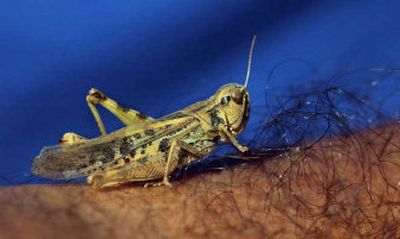Look beyond ugliness

Ladybugs and butterflies are among the insects that conjure sweet thoughts of childhood. There is a whole movement of planting butterfly gardens. No one plants a grasshopper garden.
With its beady head, gawky hind legs and armor-plated body, the grasshopper is not widely loved. Throw in images of locust plagues in the Dust Bowl and the Old Testament, and it’s clear this insect is in need of a new champion or two.
Enter entomologists John Capinera and Thomas J. Walker and illustrator Ralph D. Scott, authors of a new pocket reference to these bizarre animals and their irrepressibly noisy relatives: “Field Guide to the Grasshoppers, Katydids and Crickets of the United States” (Comstock Publishing, $20).
And no, a cricket isn’t a grasshopper. Crickets are generally dark and fat and scurry about the yard, serenading the night with their wall of sound. Grasshoppers are seen in the day, jumping and flying from grassy perches and uttering a chirp or two.
Here’s the line on grasshoppers: Yes, a few species do build to plague levels, particularly in the Great Plains, but most are not as wildly gregarious. And, as Scott’s paintings reveal, the grasshopper can be a resplendent creature, as beautifully panoplied as a Medieval knight, down to the chevrons on its femur. Some have brilliant wings, flashed only in short flights as a mating display, in bands of orange, red or blue.
“Some are pests, but many are just things of beauty,” said Capinera, chair of the entomology department at the University of Florida. “Some have beautiful songs, beautiful color patterns. I have been in places and seen them flying and you would think they were butterflies. They are really interesting insects.”
A plague – scientists refer to it dryly as an outbreak – occurs after a succession of dry seasons and when there is enough vegetation to sustain a mob. These factors may align often in certain arid parts of the country, but are rarer in the East. And when a plague does occur in the East, there is far more vegetation to sustain it, and also to hide it.
Grasshopper populations do build normally as summer blends into fall, when they become important carry-out meals for birds and mammals, such as raccoons and foxes. Several bird species rely on them, including meadowlarks, various owls and bluebirds.
More than 200 grasshopper species live in North America, of which 40 can be found in the gardens, fields and pastures of the Washington area. Among the most common are the marsh meadow grasshopper, which is a creature of variable coloration, but typically with a light brown top and green sides; and the spotted-wing grasshopper, which is a drab brown and not destined for widespread adulation. The orange-winged grasshopper, on the other hand, is a local beauty, camouflaged like an army truck until it flies, and then showing a gaudy orange-and-black wing.
The grasshopper groupie will have to go farther afield to find the chameleon-like great crested grasshopper, found from Mexico to Nebraska, or the astonishing pictured grasshopper, banded in black and yellow with orange spots. It is found along the western edge of the Great Plains, where it is sometimes, and understandably, called the barber-pole grasshopper.
You will have to look really hard to find the pygmy grasshoppers, which start at a quarter-inch long and don’t get much bigger. Scott has rendered them far larger on the page, and generally uses a microscope to examine and paint all specimens. Based in grasshopper-rich Billings, Mont., he nevertheless traveled to more than 40 states over seven years for the project. He would pull his truck off to the side of a back road somewhere and go searching with his net. This would soon spur the curiosity of a rancher. “When you tell them what you’re doing, just about everybody has a grasshopper story.”
At home, he has live specimens in jars, eating romaine lettuce, oblivious to the human eyes viewing them through a magnifying glass. “Watching their jaws going back and forth, and taking their legs and licking and cleaning off their jaws, it’s very fascinating.”
Grasshoppers make their chirping by scraping body parts together, usually by rubbing their hind leg against their forewing, or the forewing grating against the hindwing. The more lyrical songs of the cricket and katydid are made by rubbing their forewings together.
The males make most of the noise, to draw females and to keep other males at bay.
Many species of crickets are so similar that they can only be distinguished by their song. The book tells you how to cage males and record their songs, and to analyze the calls on a computer. It also points readers to the Web site, Singing Insects of North America (http://buzz.ifas.ufl.edu).